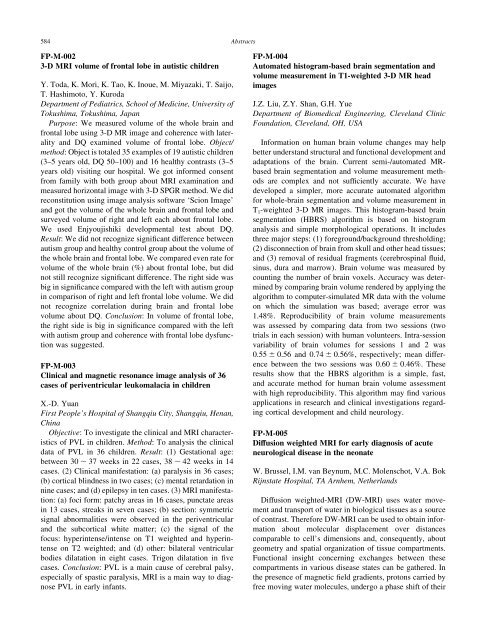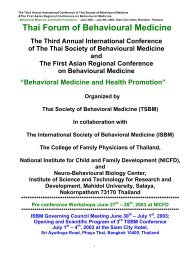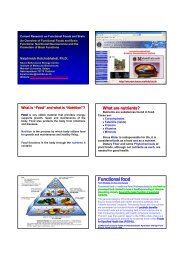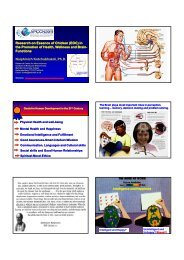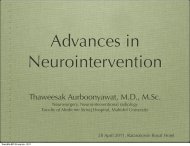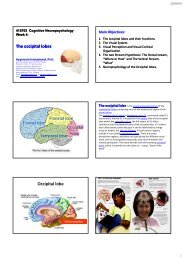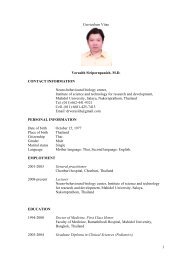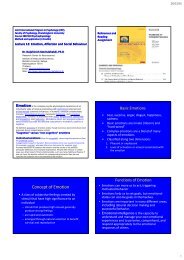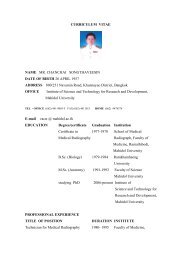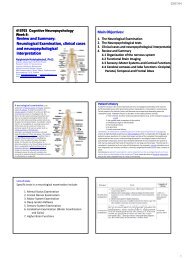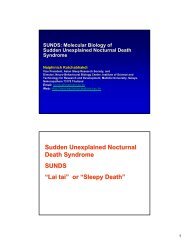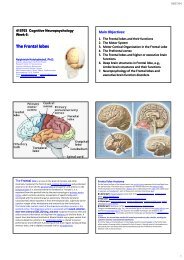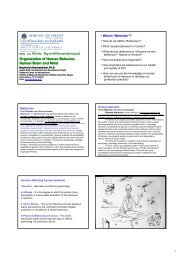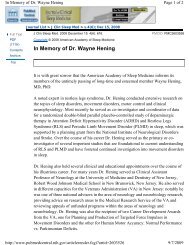PDF File - Mahidol University
PDF File - Mahidol University
PDF File - Mahidol University
Create successful ePaper yourself
Turn your PDF publications into a flip-book with our unique Google optimized e-Paper software.
584<br />
Abstracts<br />
FP-M-002<br />
3-D MRI volume of frontal lobe in autistic children<br />
Y. Toda, K. Mori, K. Tao, K. Inoue, M. Miyazaki, T. Saijo,<br />
T. Hashimoto, Y. Kuroda<br />
Department of Pediatrics, School of Medicine, <strong>University</strong> of<br />
Tokushima, Tokushima, Japan<br />
Purpose: We measured volume of the whole brain and<br />
frontal lobe using 3-D MR image and coherence with laterality<br />
and DQ examined volume of frontal lobe. Object/<br />
method: Object is totaled 35 examples of 19 autistic children<br />
(3–5 years old, DQ 50–100) and 16 healthy contrasts (3–5<br />
years old) visiting our hospital. We got informed consent<br />
from family with both group about MRI examination and<br />
measured horizontal image with 3-D SPGR method. We did<br />
reconstitution using image analysis software ‘Scion Image’<br />
and got the volume of the whole brain and frontal lobe and<br />
surveyed volume of right and left each about frontal lobe.<br />
We used Enjyoujishiki developmental test about DQ.<br />
Result: We did not recognize significant difference between<br />
autism group and healthy control group about the volume of<br />
the whole brain and frontal lobe. We compared even rate for<br />
volume of the whole brain (%) about frontal lobe, but did<br />
not still recognize significant difference. The right side was<br />
big in significance compared with the left with autism group<br />
in comparison of right and left frontal lobe volume. We did<br />
not recognize correlation during brain and frontal lobe<br />
volume about DQ. Conclusion: In volume of frontal lobe,<br />
the right side is big in significance compared with the left<br />
with autism group and coherence with frontal lobe dysfunction<br />
was suggested.<br />
FP-M-003<br />
Clinical and magnetic resonance image analysis of 36<br />
cases of periventricular leukomalacia in children<br />
X.-D. Yuan<br />
First People’s Hospital of Shangqiu City, Shangqiu, Henan,<br />
China<br />
Objective: To investigate the clinical and MRI characteristics<br />
of PVL in children. Method: To analysis the clinical<br />
data of PVL in 36 children. Result: (1) Gestational age:<br />
between 30 , 37 weeks in 22 cases, 38 , 42 weeks in 14<br />
cases. (2) Clinical manifestation: (a) paralysis in 36 cases;<br />
(b) cortical blindness in two cases; (c) mental retardation in<br />
nine cases; and (d) epilepsy in ten cases. (3) MRI manifestation:<br />
(a) foci form: patchy areas in 16 cases, punctate areas<br />
in 13 cases, streaks in seven cases; (b) section: symmetric<br />
signal abnormalities were observed in the periventricular<br />
and the subcortical white matter; (c) the signal of the<br />
focus: hyperintense/intense on T1 weighted and hyperintense<br />
on T2 weighted; and (d) other: bilateral ventricular<br />
bodies dilatation in eight cases. Trigon dilatation in five<br />
cases. Conclusion: PVL is a main cause of cerebral palsy,<br />
especially of spastic paralysis, MRI is a main way to diagnose<br />
PVL in early infants.<br />
FP-M-004<br />
Automated histogram-based brain segmentation and<br />
volume measurement in T1-weighted 3-D MR head<br />
images<br />
J.Z. Liu, Z.Y. Shan, G.H. Yue<br />
Department of Biomedical Engineering, Cleveland Clinic<br />
Foundation, Cleveland, OH, USA<br />
Information on human brain volume changes may help<br />
better understand structural and functional development and<br />
adaptations of the brain. Current semi-/automated MRbased<br />
brain segmentation and volume measurement methods<br />
are complex and not sufficiently accurate. We have<br />
developed a simpler, more accurate automated algorithm<br />
for whole-brain segmentation and volume measurement in<br />
T 1 -weighted 3-D MR images. This histogram-based brain<br />
segmentation (HBRS) algorithm is based on histogram<br />
analysis and simple morphological operations. It includes<br />
three major steps: (1) foreground/background thresholding;<br />
(2) disconnection of brain from skull and other head tissues;<br />
and (3) removal of residual fragments (cerebrospinal fluid,<br />
sinus, dura and marrow). Brain volume was measured by<br />
counting the number of brain voxels. Accuracy was determined<br />
by comparing brain volume rendered by applying the<br />
algorithm to computer-simulated MR data with the volume<br />
on which the simulation was based; average error was<br />
1.48%. Reproducibility of brain volume measurements<br />
was assessed by comparing data from two sessions (two<br />
trials in each session) with human volunteers. Intra-session<br />
variability of brain volumes for sessions 1 and 2 was<br />
0.55 ^ 0.56 and 0.74 ^ 0.56%, respectively; mean difference<br />
between the two sessions was 0.60 ^ 0.46%. These<br />
results show that the HBRS algorithm is a simple, fast,<br />
and accurate method for human brain volume assessment<br />
with high reproducibility. This algorithm may find various<br />
applications in research and clinical investigations regarding<br />
cortical development and child neurology.<br />
FP-M-005<br />
Diffusion weighted MRI for early diagnosis of acute<br />
neurological disease in the neonate<br />
W. Brussel, I.M. van Beynum, M.C. Molenschot, V.A. Bok<br />
Rijnstate Hospital, TA Arnhem, Netherlands<br />
Diffusion weighted-MRI (DW-MRI) uses water movement<br />
and transport of water in biological tissues as a source<br />
of contrast. Therefore DW-MRI can be used to obtain information<br />
about molecular displacement over distances<br />
comparable to cell’s dimensions and, consequently, about<br />
geometry and spatial organization of tissue compartments.<br />
Functional insight concerning exchanges between these<br />
compartments in various disease states can be gathered. In<br />
the presence of magnetic field gradients, protons carried by<br />
free moving water molecules, undergo a phase shift of their


